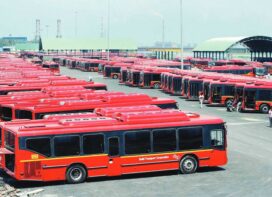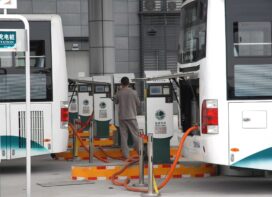 In the past two years, China has become the world’s fastest-growing market for high-speed city buses. So, despite the Chinese wanting to join the international bandwagon of adding to the already existing two billion cars, this parallel arrangement of BRTS has proved to be a boon to the users of congested roads. Early this year, the southern city of Guangzhou rolled out China’s latest effort, a 14-mile stretch of a main road striped with bus-only lanes down the middle. The sleek buses race between raised stations that resemble train stops. The number of users has already shattered the figures of many other bus systems in Asia. It handles 800,000 trips a day. About a dozen Chinese cities have working BRT systems today, and dozens more are in the works.
In the past two years, China has become the world’s fastest-growing market for high-speed city buses. So, despite the Chinese wanting to join the international bandwagon of adding to the already existing two billion cars, this parallel arrangement of BRTS has proved to be a boon to the users of congested roads. Early this year, the southern city of Guangzhou rolled out China’s latest effort, a 14-mile stretch of a main road striped with bus-only lanes down the middle. The sleek buses race between raised stations that resemble train stops. The number of users has already shattered the figures of many other bus systems in Asia. It handles 800,000 trips a day. About a dozen Chinese cities have working BRT systems today, and dozens more are in the works.
Guangzhou is the industrial power house of China; in 2007, its gross domestic product grew 16%. That economic muscle had already made Zhongshan Avenue, a key vein running through the city centre, one of the busiest bus corridors in the world. Yet traffic was glacial. Giving buses priority lanes and signals made no difference in the zig-zagging free-for-all between cars, buses and unflinching pedestrians. A U.S.-headquartered nongovernmental organisation, the Institute for Transportation and Development Policy, approached Guangzhou’s then-mayor with a far-out proposal: Dig up the middle of Zhongshan Avenue, set up sparkling bus terminals and give the buses their own lanes. Cars had to be relegated to the edges.
The mayor, Zhang Guangming and top city officials visited South America, home of the best BRTS in the world. In São Paulo, Brazil, Zhang was captivated by the buses freewheeling in their dedicated lanes. By late 2004, plans were being laid in Guangzhou too. Though BRTS was not new to China, the mayor faced a lot of hurdles, basically because the project was taking 24 meters out of the middle of the road and the bus stations were designed to have 200 metre length with multiple pick up points.
Comprehensive statistics on the system may not be available till Fall, but ITDP, an accounting method being developed by the U.N. Environment Programme, indicates that Guangzhou’s BRTs reduce about 20,000 tonnes of CO2 a year — the equivalent of the emissions from about 4,000 cars in the United States. Most of that comes from the fact that the buses can move faster without cars coming in the way. The BRTs can also use longer buses which means fewer number of total vehicles are needed.
The BRT also loosens traffic in other parts of town. Cars can move more quickly without buses crowding the lanes; pedestrians and cyclists can also breathe a bit easy. Considering these indirect impacts, the Guangzhou BRTs may save as much as 200,000 tonnes of CO2 a year.
Worldwide, BRTS tends to draw converts: Between 10 and 15 percent of riders are thought to be riding in lieu of driving their cars. Cities may be choosing BRTS more for beating traffic congestion than for its climate benefits.
 TrafficInfraTech Magazine Linking People Places & Progress
TrafficInfraTech Magazine Linking People Places & Progress


